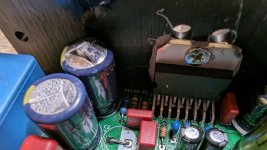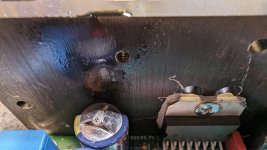Folks:
My daughter and I are nearly finished with her new integrated amp project -- everything seems to be working fine, except for one thing: every change to the attenuator results in an audible (i.e., through the speakers) popping sound. The attenuator is a DACT unit that was salvaged from my daughter's old amp, and it has never exhibited this issue before. The integrated amp consists of a pair of Xmas amps, B-buffers (unity gain diamond buffers) from RJM Audio, separate power supplies for the amps and buffers, and the usual ancillaries (including the DACT) all crammed into a small chassis.
Can someone please suggest something that might eliminate (or at least ameliorate) the problem?
Regards,
Scott
My daughter and I are nearly finished with her new integrated amp project -- everything seems to be working fine, except for one thing: every change to the attenuator results in an audible (i.e., through the speakers) popping sound. The attenuator is a DACT unit that was salvaged from my daughter's old amp, and it has never exhibited this issue before. The integrated amp consists of a pair of Xmas amps, B-buffers (unity gain diamond buffers) from RJM Audio, separate power supplies for the amps and buffers, and the usual ancillaries (including the DACT) all crammed into a small chassis.
Can someone please suggest something that might eliminate (or at least ameliorate) the problem?
Regards,
Scott
Hey Scott,
Do your boards have the R20 resistor near the input? I built a set of version one boards without this resistor and they were more noisy switching inputs or so I remember.
Do your boards have the R20 resistor near the input? I built a set of version one boards without this resistor and they were more noisy switching inputs or so I remember.
Signal lost:
Yup, the Xmas amp boards are fully populated, including R20. For the record, I'm not hearing any issues when switching inputs -- only when adjusting the volume.
Regards,
Scott
Yup, the Xmas amp boards are fully populated, including R20. For the record, I'm not hearing any issues when switching inputs -- only when adjusting the volume.
Regards,
Scott
My Dact pot contacts became dirty over the years with similar popping sounds. Had to disassemble and wipe with contact cleaner.
It may sound redundant, but did you check if the buffer (no input or output capacitor) has any residual offset DC voltage? This voltage could also origin from the signal source, since the buffer will probably pass it on without change. - In my experience, some DC voltage offset will almost all the time create noises in voltage dividers when you change values (scratchy noises in pots, or popping sound in switched attenuators).
If the buffer itself should be the culprit, you should adjust the supply voltages for 0V DC at the output. I case you are not sure, add a capacitor (say, 10uF non-polar) between the buffer and the DACT attenuator. This will eliminate the offset.
And - I hope you did not forget the input resistor for the buffer (100k or less, for the input impedance), since there is no place for it on the board itself.
If the buffer itself should be the culprit, you should adjust the supply voltages for 0V DC at the output. I case you are not sure, add a capacitor (say, 10uF non-polar) between the buffer and the DACT attenuator. This will eliminate the offset.
And - I hope you did not forget the input resistor for the buffer (100k or less, for the input impedance), since there is no place for it on the board itself.
lohk:
Yes, you may have identified the issue -- the amp does not have caps between the attenuator and buffers. There is very little room left in the chassis, so it may take me a while to figure out how to shoehorn a pair of caps in place (I have a bunch of spare Cornell Dubilier 940c 0.47uF caps lying around. They're big, which may be a problem in this case), but that seems like a smart thing to check.
And yes, there is a 20k resistor installed across the input on each buffer (also a good reminder -- thanks).
Regards,
Scott
Yes, you may have identified the issue -- the amp does not have caps between the attenuator and buffers. There is very little room left in the chassis, so it may take me a while to figure out how to shoehorn a pair of caps in place (I have a bunch of spare Cornell Dubilier 940c 0.47uF caps lying around. They're big, which may be a problem in this case), but that seems like a smart thing to check.
And yes, there is a 20k resistor installed across the input on each buffer (also a good reminder -- thanks).
Regards,
Scott
That’s why we always have a DC blocking cap on the input stage of an amp. As lohk said, anytime you can hear scratchiness or pops or noise when turning the volume pot, that’s caused by a finite DC current going through the pot. Some input stages use FETs which have very little input current on their gates. They tend to be more resistant to volume scratching noises. But a cap will always make sure there is no DC coming from the source to muck things up.
There are those who believe that any cap in the signal path is evil though. I wonder what they use for a speaker crossover if there are no capacitors? 🙂
If you need to get a quick experiment to confirm this cause, try any small cap you have if space is an issue.
I have a whole bag of 35cent 10uF 35v Silmic II caps that are the size of medicine capsule pill. They have excelled in listening tests and measurements. I use them all the time and not sure if I can tell the difference when replacing with a film cap 100x the size.
There are those who believe that any cap in the signal path is evil though. I wonder what they use for a speaker crossover if there are no capacitors? 🙂
If you need to get a quick experiment to confirm this cause, try any small cap you have if space is an issue.
I have a whole bag of 35cent 10uF 35v Silmic II caps that are the size of medicine capsule pill. They have excelled in listening tests and measurements. I use them all the time and not sure if I can tell the difference when replacing with a film cap 100x the size.
While testing these TDA7293 amp modules, I built a while back. This is what happened.
The first channel module I tested, started up, and worked fine while I listened to it in the background. I wasn't so fortunate with the 2nd channel.
After slowing turning up the variac, the amp kicked in, I heard a couple short scratching sound bursts and then a loud pop and the magic smoke was released! Quickly switched off the variac. This is what happens when a electrolytic cap blows up! 🙂 And the reason being? It was installed with polarities reversed. 🙁 Question is; did it take out anything with it when it blew? I did replace the destroyed part, and all seems back to normal.
Lesson: Always double-check your capacitors for correct installation!
The first channel module I tested, started up, and worked fine while I listened to it in the background. I wasn't so fortunate with the 2nd channel.
After slowing turning up the variac, the amp kicked in, I heard a couple short scratching sound bursts and then a loud pop and the magic smoke was released! Quickly switched off the variac. This is what happens when a electrolytic cap blows up! 🙂 And the reason being? It was installed with polarities reversed. 🙁 Question is; did it take out anything with it when it blew? I did replace the destroyed part, and all seems back to normal.
Lesson: Always double-check your capacitors for correct installation!
Attachments
Welcome in the boat😉.
this happens at a small cap and you learnt / warned....(me too...)
be happy that you don´t miss polarity at a huge cap😉
chris
this happens at a small cap and you learnt / warned....(me too...)
be happy that you don´t miss polarity at a huge cap😉
chris
I had that happen to me with a 220uF 50v cap and it was quite an explosion like a large fire cracker. Debris everywhere and luckily I did not get hurt. I always turn my amps on for the first time while wearing safety goggles standing 6 ft away now.
After blowing holes in a couple 2SC5200 I do the same, while also cowering behind the couch and using a smart plug to power on for the first time. This was of course before I setup a dim bulb tester and got a variac.

The most spectacular fail I have seen is a GaN FET which went supernova like a little star. 🙂
It vaporized itself and left a crater on the PCB.
The parts are small (about size and look of a large 2510 SMT chip resistor but made of metal) and all that passing enough power for a 400W amp.
It vaporized itself and left a crater on the PCB.
The parts are small (about size and look of a large 2510 SMT chip resistor but made of metal) and all that passing enough power for a 400W amp.
Fortunately for me, I was standing back a few feet and not directly over the amp. Plus, the heatsink was between me and the fireworks, so I didn't see the flash directly. Just heard the loud pop and the smoke rising from behind the heatsink. You could easily see the oil splattered on the heatsink. Live, and lessoned learned. I guess it's a dubious distinction being in the boat. 🙂
You folks lead more exciting lives than me: my experience has consistently been a disappointingly small "pop" and a tiny puff of smoke. I'd feel better about screwing up if the results were spectacular. When the magic smoke release is pathetic, I feel disappointed on several fronts.
Regards.
Regards.
Ironically, I've just achieved the kind of "magic smoke" success that xrk971, redjr and bloqhed described. I stupidly decided to save some money by purchasing a few TDA7293 ICs from a Chinese vendor and -- shockingly -- things did not go well. Lesson learned and the order I had planned on placing with Newark now includes a few TDA7293s. I'll continue buying standoffs, screws, knobs, feet and other basic parts from inexpensive Chinese sources but will spend the few extra bucks to get the operative components from reliable sources.
And yup, the attached clip is exactly what you'd expect.
Regards.
And yup, the attached clip is exactly what you'd expect.
Regards.
Attachments
SRMcGee, you should have been warned sufficiently to avoid buying cheap Chinese stuff. Anyway, an impressive video 😆 !
Best regards!
Best regards!
- Home
- Amplifiers
- Chip Amps
- Xmas Amp - Dibya's TDA7293 by Jhofland

